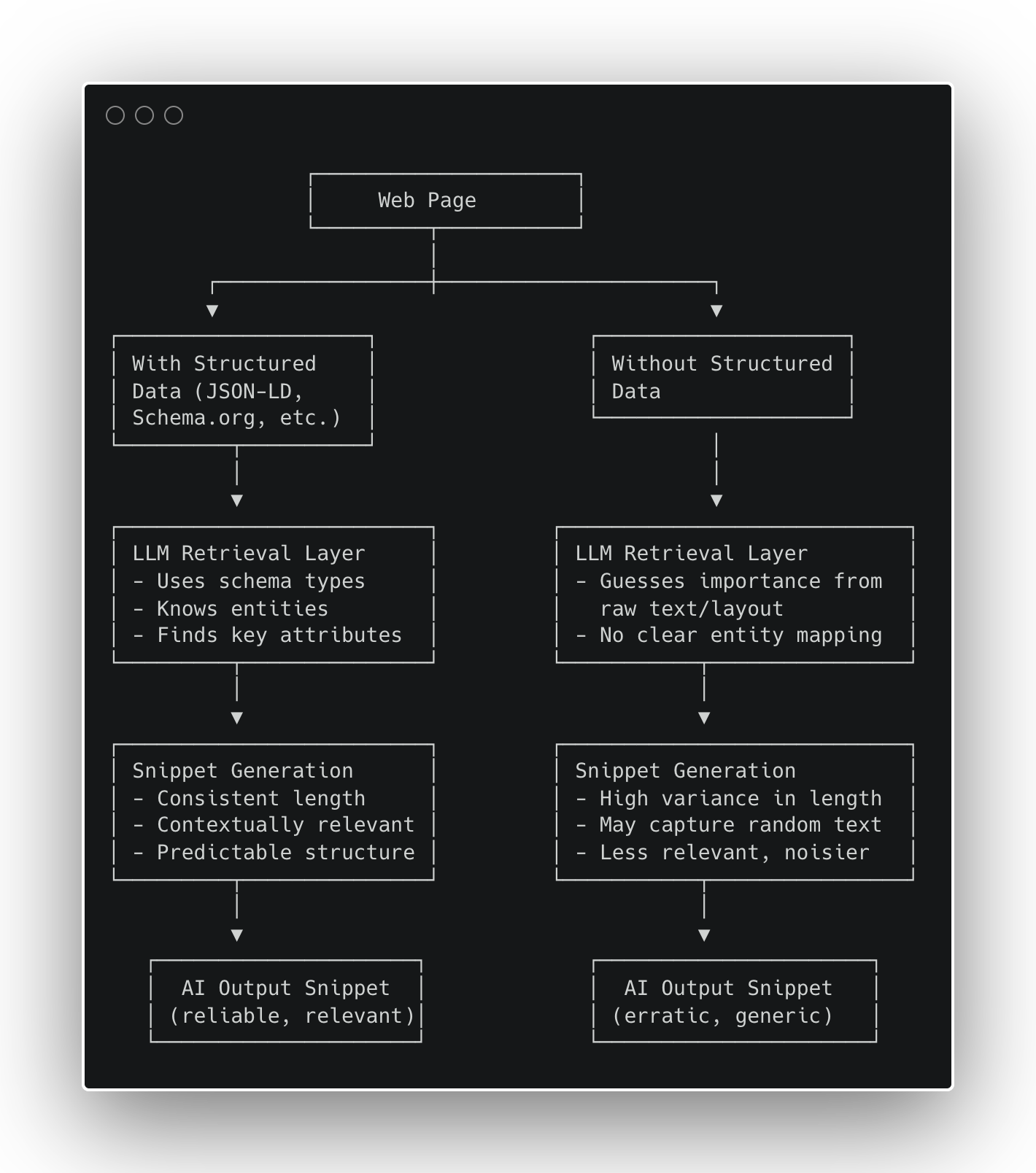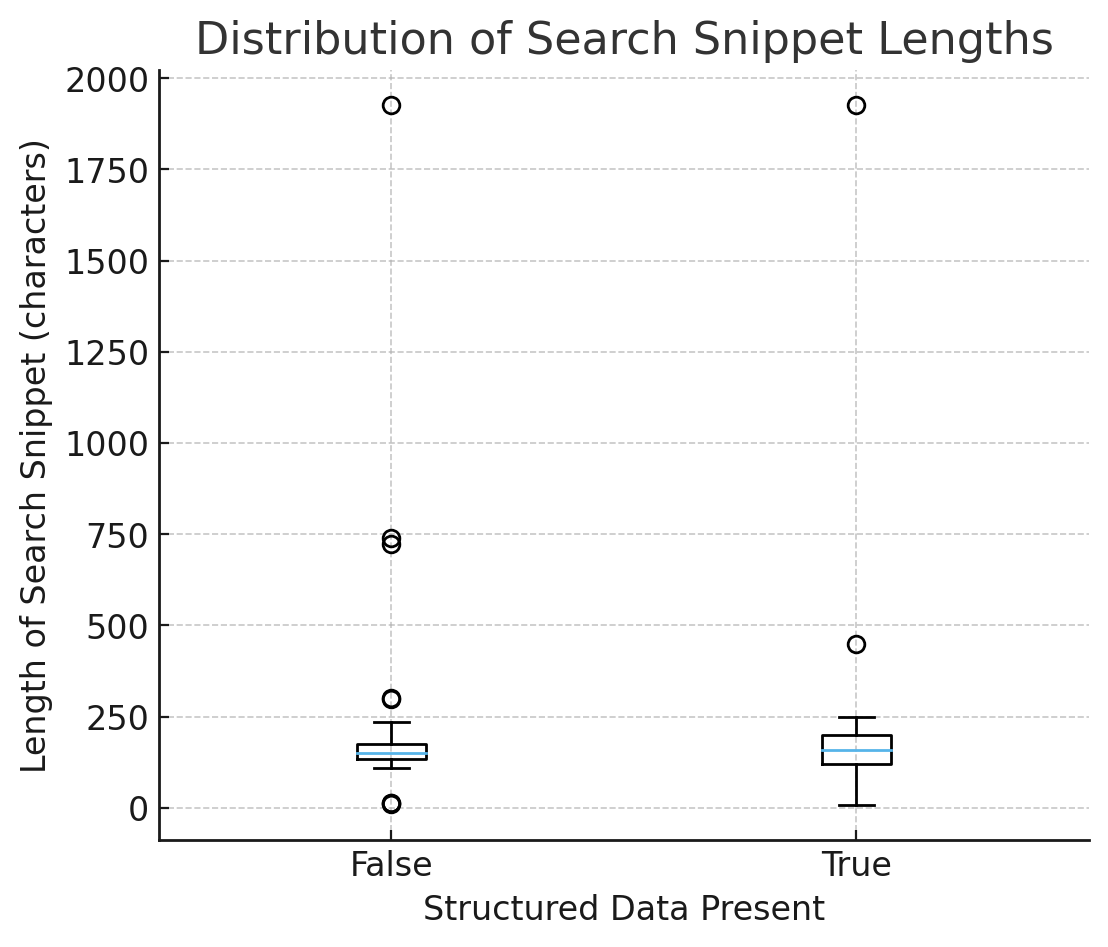When conversational AIs like ChatGPT, Perplexity, or Google AI Mode generate snippets or answer summaries, they’re not writing from scratch, they’re picking, compressing, and reassembling what webpages offer. If your content isn’t SEO-friendly and indexable, it won’t make it into generative search at all. Search, as we know it, is now a function of artificial intelligence.
But what if your page doesn’t “offer” itself in a machine-readable form? That’s where structured data comes in, not just as an SEO gig, but as a scaffold for AI to reliably pick the “right facts.” There has been some confusion in our community, and in this article, I will:
- walk through controlled experiments on 97 webpages showing how structured data improves snippet consistency and contextual relevance,
- map those results into our semantic framework.
Many have asked me in recent months if LLMs use structured data, and I’ve been repeating over and over that an LLM doesn’t use structured data as it has no direct access to the world wide web. An LLM uses tools to search the web and fetch webpages. Its tools – in most cases – greatly benefit from indexing structured data.

In our early results, structured data increases snippet consistency and improves contextual relevance in GPT-5. It also hints at extending the effective wordlim envelope – this is a hidden GPT-5 directive that decides how many words your content gets in a response. Imagine it as a quota on your AI visibility that gets expanded when content is richer and better-typed. You can read more about this concept, which I first outlined on LinkedIn.
Why This Matters Now
- Wordlim constraints: AI stacks operate with strict token/character budgets. Ambiguity wastes budget; typed facts conserve it.
- Disambiguation & grounding: Schema.org reduces the model’s search space (“this is a Recipe/Product/Article”), making selection safer.
- Knowledge graphs (KG): Schema often feeds KGs that AI systems consult when sourcing facts. This is the bridge from web pages to agent reasoning.
My personal thesis is that we want to treat structured data as the instruction layer for AI. It doesn’t “rank for you,” it stabilizes what AI can say about you.
Experiment Design (97 URLs)
While the sample size was small, I wanted to see how ChatGPT’s retrieval layer actually works when used from its own interface, not through the API. To do this, I asked GPT-5 to search and open a batch of URLs from different types of websites and return the raw responses.
You can prompt GPT-5 (or any AI system) to show the verbatim output of its internal tools using a simple meta-prompt. After collecting both the search and fetch responses for each URL, I ran an Agent WordLift workflow [disclaimer, our AI SEO Agent] to analyze every page, checking whether it included structured data and, if so, identifying the specific schema types detected.
These two steps produced a dataset of 97 URLs, annotated with key fields:
- has_sd → True/False flag for structured data presence.
- schema_classes → the detected type (e.g., Recipe, Product, Article).
- search_raw → the “search-style” snippet, representing what the AI search tool showed.
- open_raw → a fetcher summary, or structural skim of the page by GPT-5.
Using a “LLM-as-a-Judge” approach powered by Gemini 2.5 Pro, I then analyzed the dataset to extract three main metrics:
- Consistency: distribution of search_raw snippet lengths (box plot).
- Contextual relevance: keyword and field coverage in open_raw by page type (Recipe, E-comm, Article).
- Quality score: a conservative 0–1 index combining keyword presence, basic NER cues (for e-commerce), and schema echoes in the search output.
The Hidden Quota: Unpacking “wordlim”
While running these tests, I noticed another subtle pattern, one that might explain why structured data leads to more consistent and complete snippets. Inside GPT-5’s retrieval pipeline, there’s an internal directive informally known as wordlim: a dynamic quota determining how much text from a single webpage can make it into a generated answer.
At first glance, it acts like a word limit, but it’s adaptive. The richer and better-typed a page’s content, the more room it earns in the model’s synthesis window.
From my ongoing observations:
- Unstructured content (e.g., a standard blog post) tends to get about ~200 words.
- Structured content (e.g., product markup, feeds) extends to ~500 words.
- Dense, authoritative sources (APIs, research papers) can reach 1,000+ words.
This isn’t arbitrary. The limit helps AI systems:
- Encourage synthesis across sources rather than copy-pasting.
- Avoid copyright issues.
- Keep answers concise and readable.
Yet it also introduces a new SEO frontier: your structured data effectively raises your visibility quota. If your data isn’t structured, you’re capped at the minimum; if it is, you grant AI more trust and more space to feature your brand.
While the dataset isn’t yet large enough to be statistically significant across every vertical, the early patterns are already clear – and actionable.

Results

1) Consistency: Snippets Are More Predictable With Schema
In the box plot of search snippet lengths (with vs. without structured data):
- Medians are similar → schema doesn’t make snippets longer/shorter on average.
- Spread (IQR and whiskers) is tighter when has_sd = True → less erratic output, more predictable summaries.
Interpretation: Structured data doesn’t inflate length; it reduces uncertainty. Models default to typed, safe facts instead of guessing from arbitrary HTML.
2) Contextual Relevance: Schema Guides Extraction
- Recipes: With Recipe schema, fetch summaries are far likelier to include ingredients and steps. Clear, measurable lift.
- Ecommerce: The search tool often echoes JSON‑LD fields (e.g., aggregateRating, offer, brand) evidence that schema is read and surfaced. Fetch summaries skew to exact product names over generic terms like “price,” but the identity anchoring is stronger with schema.
- Articles: Small but present gains (author/date/headline more likely to appear).
3) Quality Score (All Pages)
Averaging the 0–1 score across all pages:
- No schema → ~0.00
- With schema → positive uplift, driven mostly by recipes and some articles.
Even where means look similar, variance collapses with schema. In an AI world constrained by wordlim and retrieval overhead, low variance is a competitive advantage.
Beyond Consistency: Richer Data Extends The Wordlim Envelope (Early Signal)
While the dataset isn’t yet large enough for significance tests, we observed this emerging pattern:
Pages with richer, multi‑entity structured data tend to yield slightly longer, denser snippets before truncation.
Hypothesis: Typed, interlinked facts (e.g., Product + Offer + Brand + AggregateRating, or Article + author + datePublished) help models prioritize and compress higher‑value information – effectively extending the usable token budget for that page.
Pages without schema more often get prematurely truncated, likely due to uncertainty about relevance.
Next step: We’ll measure the relationship between semantic richness (count of distinct Schema.org entities/attributes) and effective snippet length. If confirmed, structured data not only stabilizes snippets – it increases informational throughput under constant word limits.
From Schema To Strategy: The Playbook
We structure sites as:
- Entity Graph (Schema/GS1/Articles/ …): products, offers, categories, compatibility, locations, policies;
- Lexical Graph: chunked copy (care instructions, size guides, FAQs) linked back to entities.
Why it works: The entity layer gives AI a safe scaffold; the lexical layer provides reusable, quotable evidence. Together they drive precision under thewordlim constraints.
Here’s how we’re translating these findings into a repeatable SEO playbook for brands working under AI discovery constraints.
- Ship JSON‑LD for core templates
- Recipes → Recipe (ingredients, instructions, yields, times).
- Products → Product + Offer (brand, GTIN/SKU, price, availability, ratings).
- Articles → Article/NewsArticle (headline, author, datePublished).
- Unify entity + lexical
Keep specs, FAQs, and policy text chunked and entity‑linked. - Harden snippet surface
Facts must be consistent across visible HTML and JSON‑LD; keep critical facts above the fold and stable. - Instrument
Track variance, not just averages. Benchmark keyword/field coverage inside machine summaries by template.
Conclusion
Structured data doesn’t change the average size of AI snippets; it changes their certainty. It stabilizes summaries and shapes what they include. In GPT-5, especially under aggressive wordlim conditions, that reliability translates into higher‑quality answers, fewer hallucinations, and greater brand visibility in AI-generated results.
For SEOs and product teams, the takeaway is clear: treat structured data as core infrastructure. If your templates still lack solid HTML semantics, don’t jump straight to JSON-LD: fix the foundations first. Start by cleaning up your markup, then layer structured data on top to build semantic accuracy and long-term discoverability. In AI search, semantics is the new surface area.
More Resources:
- AI Search Optimization: Make Your Structured Data Accessible
- CMO Guide To Schema: How Your Organization Can Implement A Structured Data Strategy
- SEO In The Age Of AI
Featured Image: TierneyMJ/Shutterstock


